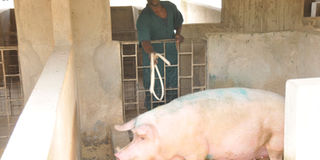What to note about pig rearing: A recap from the farm clinic

A farmer attends to a sow. One of the major aspects of rearing pigs is the suitable housing and related infrastructure. PHOTO BY MICHAEL KAKUMIRIZI
What you need to know:
Pigs are relatively small-sized animals with high reproductive potential and generation cycle. They are omnivores and therefore can be fed on a wide range of feeds.
Pigs are relatively small-sized animals with high reproductive potential and generation cycle. They are omnivores and therefore can be fed on a wide range of feeds.
Rearing them involves different aspects, namely housing and related infrastructure, feeds and methods of feeding, breeds and breeding methods, healthcare and disease control measures, routine management practices and marketing.
During construction, there should be careful siting of the sties to avoid inconveniences from smell and drainage. There should adequate ventilation, space allowance per pig, heat reduction measures for adult pigs, drainage and guard rails or crates in farrowing units. The house should provide easily cleanable floor, drinkers and feeders.
Physical disease control measures should be in place right from the time of construction such as footbaths with disinfectants, fencing to restrict unauthorised entrance and limiting access of pigs to the drainage channels. A waste management unit should be incorporated as well.
Various systems
Pigs are assets if managed well because by 2050, the demand for pork will have doubled.
In Uganda, the consumers want well prepared pork and it is better if there is control of disease, which one is likely to get from eating half-cooked or roasted pork.
There are various systems of rearing pigs. In intensive production, most farmers provide water and feed to the animals. But can also use the waste to generate biogas for energy and the by-product as a fertiliser.
In semi-intensive production, pigs are kept in kraals either throughout the day or for half-day. In extensive production, they are left to move freely. However, farmers are advised to use intensive and semi-intensive systems.
There are different breeds reared by farmers in Uganda. The most common is Large White, which has a lot of fat. In developed countries, the farmers breed it for processing fat.
There is the Landrace, which has good motherability, less fat and lean meat. The Duroc variety has good meat but lacks motherability. Another is the Camborough from South Africa. The hybrid contains combination of the characteristics above. If well-bred, it can weigh up to 120kg depending on the feeding.
Feeding
Farmers can feed their pigs with maize bran, broken maize, wheat bran, millet, rice bran, brewers waste, cassava meal, sweet potatoes meal, vegetable culls, molasses, fruit culls, incubator waste, ruminant slaughter wastes, sugar cane bagasse, bakery waste and forages.
Other feed sources include soya bean meal, sunflower cakes, tree leaves and stems, palm kernel meal, meat and bone scrapings, blood meal, fish meal, whey and mineral premixes.
But they should not feed pigs with moldy feeds like spoilt bakery wastes because they are toxic.
Diseases
However farmers have to be careful in selecting feeds from contaminated sources where they may introduce a disease like African swine fever into your herd.
For diseases, the most dangerous that affects pigs in Africa and some parts of eastern Europe is the African swine fever. No vaccine has yet been developed but scientists at International Livestock Research Institute (ILRI) are conducting research for a vaccine.
Other diseases include the food and mouth disease, which also affects other livestock such as cattle. The parasites include tape worms and ticks.
Piggery in Uganda
Piggery has become an important activity in Uganda. Statistics from International Livestock Research Institute (ILRI) show that Uganda has about 3.5 million with the highest per capita consumption of pork. Each person consumes four kilogrammes per year. Compare with European countries like Austria, the per capita consumption is 40kg per person per year.
There are more than 1.1 million families raising pigs in Uganda mostly as backyard activity in both urban and rural areas. Uganda is considered number one in pork consumption in East Africa and fourth in Africa.




